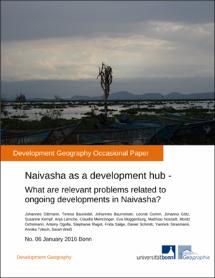Dittmann, Johannes; Bauriedel, Teresa; Baumeister, Johannes; Gomm, Leonie; Götz, Johanna; Kempf, Susanne; Lamche, Anja; Meintzinger, Claudia; Müggenburg, Eva; Nostadt, Matthias; Ochsmann, Moritz; Ogolla, Antony; Ragot, Stephanie; Salge, Frida; Schmitt, Daniel; Strasmann, Yannick; Tritsch, Annika; Weiß, Sarah: Naivasha as a development hub : What are relevant problems related to ongoing developments in Naivasha?. Bonn: Department of Geography, University of Bonn, 2016. In: Development Geography Occasional Paper, 06.
Online-Ausgabe in bonndoc: https://hdl.handle.net/20.500.11811/8652
Online-Ausgabe in bonndoc: https://hdl.handle.net/20.500.11811/8652
@techreport{handle:20.500.11811/8652,
author = {{Johannes Dittmann} and {Teresa Bauriedel} and {Johannes Baumeister} and {Leonie Gomm} and {Johanna Götz} and {Susanne Kempf} and {Anja Lamche} and {Claudia Meintzinger} and {Eva Müggenburg} and {Matthias Nostadt} and {Moritz Ochsmann} and {Antony Ogolla} and {Stephanie Ragot} and {Frida Salge} and {Daniel Schmitt} and {Yannick Strasmann} and {Annika Tritsch} and {Sarah Weiß}},
title = {Naivasha as a development hub : What are relevant problems related to ongoing developments in Naivasha?},
publisher = {Department of Geography, University of Bonn},
year = 2016,
month = jan,
series = {Development Geography Occasional Paper},
volume = 06,
note = {“It gives a feeling of security, when everyone is on board!” (Employee of NGO in Naivasha) Naivasha is known as an economic hub due to its flourish flower industry and divers landscape with the Lake Naivasha and several national parks in the area. Nevertheless, Naivasha struggles of socio-economic development and the fast population increase has reinforced it. A large number of international, regional and local non-governmental institutions (NGI) are working in Naivasha for a long time. Non-governmental institutions include all kinds of organizations who are working in the field of development, including non-governmental organizations (NGOs), FBIs, CBOs and many more. With this high density of NGIs in Naivasha, the question comes up, how these institutions coordinate their work to be efficient. Thereby, it is also important to take into consideration the cooperation with the sub-county of Naivasha, who is responsible for their coordination of government bodies. Therefore, the following main question will be asked: How is the cooperation of non-governmental institutions amongst themselves and the sub-county of Naivhasha’s administration? To get an overview of existing cooperations and also to get a better understanding of the meaning of cooperations with their benefits and challenges in Naivasha, the following four guiding questions will structure the research. 1. What cooperation and organization exist amongst non-governmental institutions and the sub-county? 2. What are the achievements of the cooperation amongst non-governmental institutions and the sub-county? 3. What are the challenges of these cooperations? 4. What are the expectations for existing and future cooperations? The research should give an idea, how the work of development cooperation is organized and structured in Naivasha. To answer these questions, several interviews with different non-governmental institutions and one interview with the Department of Social Development of the sub-county will be carried out.},
url = {https://hdl.handle.net/20.500.11811/8652}
}
author = {{Johannes Dittmann} and {Teresa Bauriedel} and {Johannes Baumeister} and {Leonie Gomm} and {Johanna Götz} and {Susanne Kempf} and {Anja Lamche} and {Claudia Meintzinger} and {Eva Müggenburg} and {Matthias Nostadt} and {Moritz Ochsmann} and {Antony Ogolla} and {Stephanie Ragot} and {Frida Salge} and {Daniel Schmitt} and {Yannick Strasmann} and {Annika Tritsch} and {Sarah Weiß}},
title = {Naivasha as a development hub : What are relevant problems related to ongoing developments in Naivasha?},
publisher = {Department of Geography, University of Bonn},
year = 2016,
month = jan,
series = {Development Geography Occasional Paper},
volume = 06,
note = {“It gives a feeling of security, when everyone is on board!” (Employee of NGO in Naivasha) Naivasha is known as an economic hub due to its flourish flower industry and divers landscape with the Lake Naivasha and several national parks in the area. Nevertheless, Naivasha struggles of socio-economic development and the fast population increase has reinforced it. A large number of international, regional and local non-governmental institutions (NGI) are working in Naivasha for a long time. Non-governmental institutions include all kinds of organizations who are working in the field of development, including non-governmental organizations (NGOs), FBIs, CBOs and many more. With this high density of NGIs in Naivasha, the question comes up, how these institutions coordinate their work to be efficient. Thereby, it is also important to take into consideration the cooperation with the sub-county of Naivasha, who is responsible for their coordination of government bodies. Therefore, the following main question will be asked: How is the cooperation of non-governmental institutions amongst themselves and the sub-county of Naivhasha’s administration? To get an overview of existing cooperations and also to get a better understanding of the meaning of cooperations with their benefits and challenges in Naivasha, the following four guiding questions will structure the research. 1. What cooperation and organization exist amongst non-governmental institutions and the sub-county? 2. What are the achievements of the cooperation amongst non-governmental institutions and the sub-county? 3. What are the challenges of these cooperations? 4. What are the expectations for existing and future cooperations? The research should give an idea, how the work of development cooperation is organized and structured in Naivasha. To answer these questions, several interviews with different non-governmental institutions and one interview with the Department of Social Development of the sub-county will be carried out.},
url = {https://hdl.handle.net/20.500.11811/8652}
}






